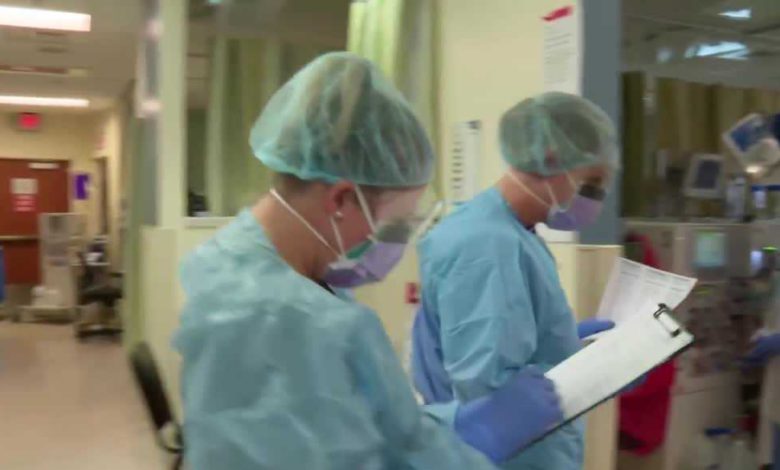
Parts of the country are running out of oxygen supply as COVID-19 cases, hospitalizations soar
Parts of the South are running out of oxygen supply as COVID-19 cases and hospitalizations continue soaring, primarily driven by the swaths of people who remain unvaccinated and a dangerous coronavirus variant that has been tirelessly infecting millions of Americans.Several hospitals in Florida, South Carolina, Texas and Louisiana are struggling with oxygen scarcity. Some are at risk of having to use their reserve supply or running out of oxygen imminently, according to state health officials and hospital consultants.With the continued uptick in COVID-19 cases, there has been more demand on the oxygen supply, and hospitals cannot keep up the pace to meet those needs, Donna Cross, who is the senior director of facilities and construction at Premier -- a health care performance improvement company -- told CNN."Normally, an oxygen tank would be about 90% full, and the suppliers would let them get down to a refill level of 30-40% left in their tank, giving them a three to five day cushion of supply," Cross explained. "What's happening now is that hospitals are running down to about 10-20%, which is a one to two day supply on hand, before they're getting backfilled."Even when they're getting backfill, it's only a partial supply of about 50%, Cross said. "It is very critical situation."Florida on Saturday had the highest COVID-19 hospitalization rate in the country, with 75 patients per 100,000 residents in hospitals with the virus, according to data from federal health officials and Johns Hopkins University. It also reached yet another pandemic high of COVID-19 cases Friday, reporting 690.5 new cases per 100,000 people each day from Aug. 20 to Aug. 26, state data showed.Dr. Ahmed Elhaddad, an intensive care unit doctor in Florida, told CNN Saturday that he's frustrated and "tired of seeing people die and suffer because they did not take a vaccine."He noted the Delta variant is "eating" people's lungs, which eventually leads to their collapse as well as heart issues."We're seeing the patients die faster with this (Delta) variant," said Elhaddad, who is the ICU medical director at Jupiter Medical Center in Florida."This round, we're seeing the younger patients -- 30, 40, 50-year-olds -- and they're suffering. They're hungry for oxygen, and they're dying. Unfortunately, this round they're dying faster," he said.Elhaddad noted that his ICU does not have a single COVID-19 patient who is vaccinated, nor did he see any vaccinated people die from COVID-19."There's no magic medicine. ... The only thing that we're finding is that the vaccine is preventing death. It's preventing patients from coming to the ICU," Elhaddad said.Florida has fully vaccinated 52.4% of its total population, data from the U.S. Centers for Disease Control and Prevention (CDC) showed Saturday. Meanwhile, less than 50% of people in South Carolina, Louisiana and Texas, where oxygen supplies are also low, are fully vaccinated. Studies have shown that full vaccination is necessary for optimal protection against the Delta variant.Nationally, 52.1% of the population is fully vaccinated, the CDC data showed.PGRpdiBjbGFzcz0iaW5mb2dyYW0tZW1iZWQiIGRhdGEtaWQ9ImJhMjIxYWIxLTEwMDQtNGI1Zi05NDAwLThlMzUzOGIzYmRhZCIgZGF0YS10eXBlPSJpbnRlcmFjdGl2ZSIgZGF0YS10aXRsZT0iVW5pdGVkIFN0YXRlcyBDT1ZJRCBWYWNjaW5lIEluZm9ncmFtIj48L2Rpdj48c2NyaXB0PiFmdW5jdGlvbihlLGksbixzKXt2YXIgdD0iSW5mb2dyYW1FbWJlZHMiLGQ9ZS5nZXRFbGVtZW50c0J5VGFnTmFtZSgic2NyaXB0IilbMF07aWYod2luZG93W3RdJiZ3aW5kb3dbdF0uaW5pdGlhbGl6ZWQpd2luZG93W3RdLnByb2Nlc3MmJndpbmRvd1t0XS5wcm9jZXNzKCk7ZWxzZSBpZighZS5nZXRFbGVtZW50QnlJZChuKSl7dmFyIG89ZS5jcmVhdGVFbGVtZW50KCJzY3JpcHQiKTtvLmFzeW5jPTEsby5pZD1uLG8uc3JjPSJodHRwczovL2UuaW5mb2dyYW0uY29tL2pzL2Rpc3QvZW1iZWQtbG9hZGVyLW1pbi5qcyIsZC5wYXJlbnROb2RlLmluc2VydEJlZm9yZShvLGQpfX0oZG9jdW1lbnQsMCwiaW5mb2dyYW0tYXN5bmMiKTs8L3NjcmlwdD4=Hurricane Ida targeting Louisiana when COVID-19 hospitalizations remain highAs Louisiana's overall vaccination rate remains among the lowest in the nation at 41.2%, and the state's hospitals are dealing with hundreds of COVID-19 patients, a hurricane is threatening the region.There are 2,450 people hospitalized with COVID-19 in Louisiana, Gov. John Bel Edwards said Saturday, which is a drop of 20% in the past 10 days. But, it's still the most the state has had since before the current surge in cases, Edwards told CNN.More than 475 of those patients are on ventilators, according to data from the state department of health.Hurricane Ida is expected to hit the state a major hurricane and possible injuries from the storm stand to compound the risk of health care facilities being extremely overwhelmed, given COVID-19 patients already occupy hospitals at high rates."Evacuating hospitals is not going to be possible because there's nowhere to bring those patients to, there's no excess capacity anywhere else in the state or outside the state," Edwards said."Then you have people who may be injured as a result of the hurricane itself, and so we need to make sure we have some capacity for them," he said. "We still have a very, very challenging situation here across the state of Louisiana," he said. Edwards pointed out that he's worried about lengthy power outages. The state as about 10,000 lineworkers ready to go and another 20,000 on standby to assist as soon as it's necessary."Restoring power is going to be critically important in order to keep these hospitals up and functioning," he said.All of the state's parishes are in the highest risk category for coronavirus, with widespread, uncontrolled transmission and many undetected cases, the state health department said.
Parts of the South are running out of oxygen supply as COVID-19 cases and hospitalizations continue soaring, primarily driven by the swaths of people who remain unvaccinated and a dangerous coronavirus variant that has been tirelessly infecting millions of Americans.
Several hospitals in Florida, South Carolina, Texas and Louisiana are struggling with oxygen scarcity. Some are at risk of having to use their reserve supply or running out of oxygen imminently, according to state health officials and hospital consultants.
With the continued uptick in COVID-19 cases, there has been more demand on the oxygen supply, and hospitals cannot keep up the pace to meet those needs, Donna Cross, who is the senior director of facilities and construction at Premier -- a health care performance improvement company -- told CNN.
"Normally, an oxygen tank would be about 90% full, and the suppliers would let them get down to a refill level of 30-40% left in their tank, giving them a three to five day cushion of supply," Cross explained. "What's happening now is that hospitals are running down to about 10-20%, which is a one to two day supply on hand, before they're getting backfilled."
Even when they're getting backfill, it's only a partial supply of about 50%, Cross said. "It is very critical situation."
Florida on Saturday had the highest COVID-19 hospitalization rate in the country, with 75 patients per 100,000 residents in hospitals with the virus, according to data from federal health officials and Johns Hopkins University. It also reached yet another pandemic high of COVID-19 cases Friday, reporting 690.5 new cases per 100,000 people each day from Aug. 20 to Aug. 26, state data showed.
Dr. Ahmed Elhaddad, an intensive care unit doctor in Florida, told CNN Saturday that he's frustrated and "tired of seeing people die and suffer because they did not take a vaccine."
He noted the Delta variant is "eating" people's lungs, which eventually leads to their collapse as well as heart issues.
"We're seeing the patients die faster with this (Delta) variant," said Elhaddad, who is the ICU medical director at Jupiter Medical Center in Florida.
"This round, we're seeing the younger patients -- 30, 40, 50-year-olds -- and they're suffering. They're hungry for oxygen, and they're dying. Unfortunately, this round they're dying faster," he said.
Elhaddad noted that his ICU does not have a single COVID-19 patient who is vaccinated, nor did he see any vaccinated people die from COVID-19.
"There's no magic medicine. ... The only thing that we're finding is that the vaccine is preventing death. It's preventing patients from coming to the ICU," Elhaddad said.
Florida has fully vaccinated 52.4% of its total population, data from the U.S. Centers for Disease Control and Prevention (CDC) showed Saturday. Meanwhile, less than 50% of people in South Carolina, Louisiana and Texas, where oxygen supplies are also low, are fully vaccinated. Studies have shown that full vaccination is necessary for optimal protection against the Delta variant.
Nationally, 52.1% of the population is fully vaccinated, the CDC data showed.
Hurricane Ida targeting Louisiana when COVID-19 hospitalizations remain high
As Louisiana's overall vaccination rate remains among the lowest in the nation at 41.2%, and the state's hospitals are dealing with hundreds of COVID-19 patients, a hurricane is threatening the region.
There are 2,450 people hospitalized with COVID-19 in Louisiana, Gov. John Bel Edwards said Saturday, which is a drop of 20% in the past 10 days. But, it's still the most the state has had since before the current surge in cases, Edwards told CNN.
More than 475 of those patients are on ventilators, according to data from the state department of health.
Hurricane Ida is expected to hit the state a major hurricane and possible injuries from the storm stand to compound the risk of health care facilities being extremely overwhelmed, given COVID-19 patients already occupy hospitals at high rates.
"Evacuating hospitals is not going to be possible because there's nowhere to bring those patients to, there's no excess capacity anywhere else in the state or outside the state," Edwards said.
"Then you have people who may be injured as a result of the hurricane itself, and so we need to make sure we have some capacity for them," he said. "We still have a very, very challenging situation here across the state of Louisiana," he said.
Edwards pointed out that he's worried about lengthy power outages. The state as about 10,000 lineworkers ready to go and another 20,000 on standby to assist as soon as it's necessary.
"Restoring power is going to be critically important in order to keep these hospitals up and functioning," he said.
All of the state's parishes are in the highest risk category for coronavirus, with widespread, uncontrolled transmission and many undetected cases, the state health department said.
Source link









